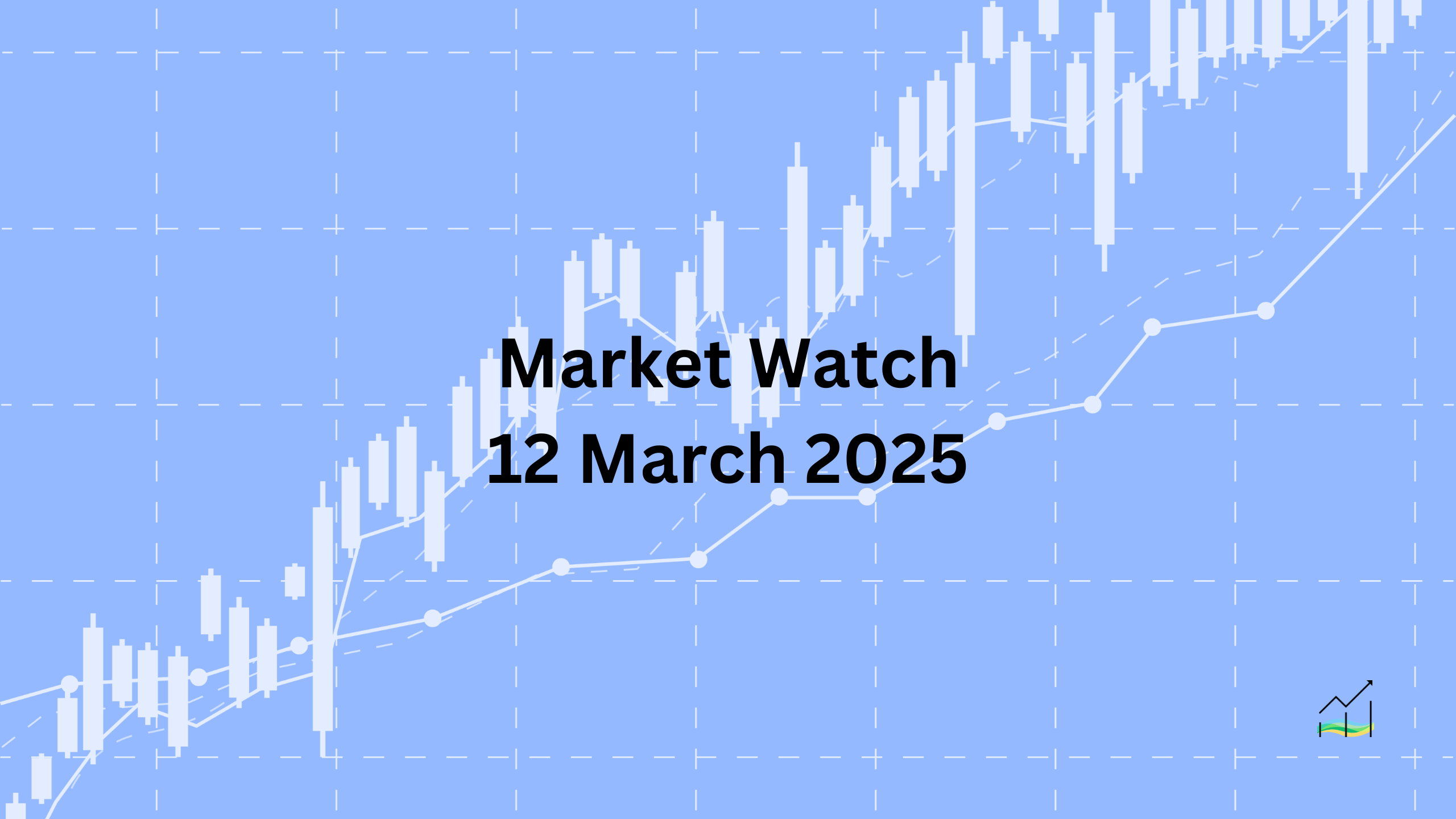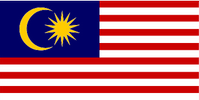12/03/2025 Market Watch

Escalating Trade War, Inflation in Focus
The trade conflict continues to intensify, straining traditional alliances in North America, Europe, and the Asia Pacific. The U.S. has imposed 25% tariffs on imported steel and aluminum, with no exemptions despite lobbying efforts. The European Union has announced retaliatory measures, though they will not take effect for a month, leaving room for negotiations. Meanwhile, the U.S. dollar is slightly stronger against most foreign currencies but remains in consolidation mode ahead of key economic events, including a potential rate cut by the Bank of Canada and the release of U.S. February CPI data.
Global bond markets remain mostly steady, except for Australia and New Zealand, where yields rose by 6-7 basis points. In Europe, yields fluctuate within a narrow range, while the U.S. 10-year Treasury yield dips below 4.27%. The U.S. Treasury is set to auction $39 billion in 10-year notes amid a soft dollar environment and no rate concessions. Equity markets in the Asia Pacific, excluding China and Hong Kong, rebounded after recent declines, and Europe's Stoxx 600 is up for the first time in five sessions. U.S. index futures also show a firmer tone.
In commodities, gold has climbed above $2,900, reaching $2,925 before consolidating. Oil prices remain stable, with April WTI holding above $66 after briefly dropping to $65.30. Market movements continue to reflect uncertainty as investors navigate trade tensions and key economic data releases.
United States of America
Overview
The U.S. dollar remains under pressure, hovering near its recent low of 103.20 on the Dollar Index. It has fallen nearly 4% this month, reaching its weakest level since October. A move above 104.00 is necessary to stabilize the technical outlook. Market attention is on the U.S. inflation data and newly imposed steel and aluminum tariffs. Unlike previous policies, aluminum tariffs have increased to 25%, signaling fewer exemptions. Additionally, expectations of a Federal Reserve rate cut in June remain high, with markets pricing in a potential policy shift due to a weakening labor market.
Economic Drivers
Several factors are influencing market sentiment:
- U.S. Dollar Weakness: The Dollar Index has declined sharply, nearing its lowest level in five months.
- Inflation Expectations: The U.S. Consumer Price Index (CPI) is projected to soften slightly on a year-over-year basis.
- Steel and Aluminum Tariffs: Unlike the previous administration’s 10% levy, the new aluminum tariff is 25%, suggesting fewer exemptions.
- Impact on Manufacturing: Higher steel and aluminum prices could reduce demand, shifting supply chains while increasing costs for U.S. consumers and industries.
- Federal Reserve Policy: Markets are pricing in a potential Fed rate cut in June due to labor market concerns rather than immediate inflation pressures.
Data and Events
Several key developments are shaping the market outlook:
- The Dollar Index remains near 103.20, with a move above 104.00 needed for stabilization.
- U.S. CPI data is expected to show a slight decline in inflation on a year-over-year basis.
- New U.S. steel and aluminum tariffs could have broader economic implications, with aluminum tariffs rising to 25%.
- Fed rate cut expectations for June remain fully priced into futures and swap markets.
- The labor market’s weakening conditions are seen as a key driver for potential monetary policy adjustments.
Price Action
The U.S. dollar continues to face downward pressure, struggling to regain strength. Inflation data and tariff impacts are in focus, with markets closely watching for signals of future Fed policy changes. The weakening labor market remains a major concern, influencing expectations for a rate cut later in the year.
Key Points:
- The Dollar Index has dropped nearly 4% this month, hovering near 103.20.
- A move above 104.00 is needed to stabilize the technical outlook.
- U.S. inflation data is expected to show slight softening.
- Steel and aluminum tariffs have increased, with fewer exemptions anticipated.
- Higher input costs could impact U.S. manufacturers and consumers.
- Market expectations for a Fed rate cut in June remain strong.
- The labor market’s deterioration is a key concern for policymakers.
Australia
Overview
The Australian dollar remains within a tight two-cent range since early February, currently hovering around $0.6300. After falling to a four-day low near $0.6260, it rebounded to $0.6310 in late North American trading. Market focus is on Australia’s upcoming consumer inflation expectations, which could impact future rate decisions. The central bank has signaled no urgency to cut rates, with markets heavily pricing in a potential rate hike in May.
Economic Drivers
Key factors influencing the Australian dollar include:
- Tight Trading Range: The Aussie remains confined within a narrow range, reflecting market indecision.
- Consumer Inflation Expectations: Inflation expectations rose to 4.6% in February from 4.0% in January, matching the 2024 high.
- Central Bank Outlook: The Reserve Bank of Australia (RBA) is not expected to cut rates in the near term, reinforcing its cautious stance.
- Rate Hike Speculation: Futures markets currently assign an 80% probability of a rate hike at the May 20 meeting.
Data and Events
Key developments affecting the market outlook:
- The Australian dollar remains around $0.6300, recovering from a recent low of $0.6260.
- The Melbourne Institute’s consumer inflation expectations report is due tomorrow.
- February’s inflation expectations rose to 4.6%, up from 4.0% in January.
- The RBA is unlikely to cut rates at its April 1 meeting.
- Futures markets indicate an 80% chance of a rate hike in May.
Price Action
The Australian dollar continues to trade within a stable range, with recent movements reflecting market uncertainty. Rising inflation expectations and the central bank’s cautious stance suggest that rate cuts are unlikely in the near term, keeping upward pressure on rate hike speculation.
Key Points:
- The Australian dollar remains within a tight two-cent range.
- Inflation expectations rose to 4.6% in February, reinforcing RBA’s cautious approach.
- The central bank is unlikely to cut rates at its April 1 meeting.
- Markets are pricing in an 80% probability of a rate hike in May.
- Traders are closely watching inflation data for further policy signals.
Canada
Overview
The U.S. dollar strengthened against the Canadian dollar, reaching CAD1.4520 amid escalating trade tensions between the two countries. The U.S. initially doubled tariffs on Canadian steel and aluminum to 50% in response to Ontario's 25% surcharge on electricity sales, but later reversed the decision after Ontario rescinded the surcharge. The U.S. dollar remains firm above CAD1.4420 but has stayed below CAD1.45. Meanwhile, the Bank of Canada is expected to announce another rate cut today, following a series of aggressive cuts in late 2024 and early 2025.
Economic Drivers
Several key factors are influencing the U.S.-Canada exchange rate and broader market sentiment:
- Trade Tensions: The U.S. and Canada continue to face disputes over tariffs, with steel and aluminum levies at the center.
- Auto Industry Threats: The U.S. has threatened Canada’s auto sector, despite U.S. brands making up 40% of vehicle sales in Canada and accounting for 62% of Canada’s automotive imports.
- Bank of Canada Policy: The central bank has already cut rates significantly and is expected to ease further.
- Inflation Trends: Canadian inflation is close to zero over the past six to seven months, supporting the case for additional monetary easing.
- Yield Spread: The U.S.-Canada two-year yield premium hit 163 basis points in February, the highest since 1997, before pulling back to 135 basis points.
Data and Events
Key market events shaping the outlook:
- The U.S. dollar reached CAD1.4520, just below last week’s high of CAD1.4540.
- The U.S. briefly doubled tariffs on Canadian steel and aluminum before reversing the decision.
- Options worth $645 million at CAD1.4380 expire today.
- The Bank of Canada meets today, with a rate cut widely expected.
- The Bank of Canada has already delivered 125 basis points of cuts between September and December 2024, followed by a 25-basis-point cut in January.
- The swaps market has priced in another 50 basis points of rate cuts for the remainder of the year.
Price Action
The U.S. dollar remains strong against the Canadian dollar, supported by ongoing trade tensions and diverging monetary policies. The market is closely watching the Bank of Canada’s decision, which could influence the trajectory of further rate cuts. The narrowing U.S.-Canada yield spread may also play a role in future exchange rate movements.
Key Points:
- The U.S. dollar strengthened to CAD1.4520 amid trade tensions.
- The U.S. briefly doubled steel and aluminum tariffs to 50% before reversing.
- Canada's auto industry remains vulnerable to U.S. trade threats.
- The Bank of Canada is expected to announce another rate cut today.
- Canadian inflation is near zero over a six-to-seven-month period.
- Markets anticipate another 50 basis points of rate cuts this year.
- The U.S.-Canada yield spread has narrowed from 163 to 135 basis points.
China
Overview
The U.S. dollar hit a new yearly low near CNH7.2155 before rebounding to CNH7.25, reflecting broader dollar weakness. Despite expectations that Chinese authorities might allow the yuan to weaken to counter U.S. tariffs, the currency remains relatively stable. The offshore yuan has gained 1.3% this year, while the onshore yuan has risen by 0.8%. The People’s Bank of China (PBOC) adjusted the dollar’s reference rate lower, reinforcing stability. Meanwhile, Chinese and Hong Kong stocks have outperformed U.S. indices, despite the U.S. increasing tariffs on imports from these regions by 20%.
Economic Drivers
Several factors are shaping the yuan’s performance:
- U.S. Dollar Weakness: The dollar continues to decline, contributing to the yuan’s relative strength.
- Policy Intervention: Chinese authorities have maintained a stable yuan rather than allowing it to depreciate.
- Tariff Impact: The U.S. raised tariffs on Chinese and Hong Kong imports by 20%, but markets have remained resilient.
- Equity Performance: Hong Kong and mainland Chinese stocks listed in Hong Kong have outperformed U.S. markets.
- Bond Yield Spread: The U.S. 10-year yield premium over China has narrowed by over 50 basis points since the end of last year.
Data and Events
Key developments affecting the market:
- The U.S. dollar dropped to CNH7.2155 before recovering to CNH7.25.
- The onshore yuan has strengthened by 0.8% against the U.S. dollar this year, while the offshore yuan has gained 1.3%.
- The PBOC set the dollar’s reference rate lower at CNY7.1696, close to last week’s low of CNY7.1692.
- The U.S. increased tariffs on Chinese and Hong Kong imports by 20%.
- Chinese and Hong Kong stocks have outperformed U.S. indices despite trade tensions.
- The U.S. 10-year yield premium over China has contracted by more than 50 basis points since late last year.
Price Action
The yuan remains stable despite pressure from U.S. trade policies, with both onshore and offshore yuan posting gains this year. The narrowing yield differential between the U.S. and China, along with steady PBOC interventions, has helped maintain currency stability. Meanwhile, Chinese and Hong Kong stocks continue to show resilience.
Key Points:
- The U.S. dollar weakened to CNH7.2155 before rebounding to CNH7.25.
- The offshore yuan has gained 1.3% this year, while the onshore yuan is up 0.8%.
- The PBOC adjusted the dollar’s reference rate lower, maintaining currency stability.
- U.S. tariffs on Chinese and Hong Kong imports increased by 20%.
- Chinese and Hong Kong stocks have outperformed U.S. markets.
- The U.S. 10-year yield premium over China has narrowed by more than 50 basis points.
Europe
Overview
The euro climbed to nearly $1.0950 as U.S.-Canada trade tensions and upcoming fiscal policy shifts in Europe weighed on the U.S. dollar. The currency is currently consolidating between $1.0890 and $1.0925, with the next key resistance at $1.10. A break below $1.0880 could trigger some selling pressure. Meanwhile, the European economic calendar remains quiet, with little market reaction to the collapse of Portugal’s government. The EU has announced retaliatory tariffs on $26 billion worth of U.S. goods, set to take effect in mid-April.
Economic Drivers
Several factors are influencing the euro’s movement:
- Trade Tensions: The U.S.-Canada trade conflict is seen as weakening U.S. growth prospects, benefiting the euro.
- European Fiscal Changes: Policy adjustments in the EU have added to the euro’s appeal.
- U.S. Dollar Consolidation: The euro remains within a tight trading range, with resistance at $1.10 and support at $1.0880.
- EU Retaliatory Tariffs: The European Union has imposed tariffs on U.S. goods, including steel, aluminum, textiles, agricultural products, and home appliances.
- German Bond Yield Curve: The 2-10-year German yield curve has steepened by 30 basis points this month, signaling a shift in market expectations.
Data and Events
Key developments affecting the market outlook:
- The euro reached $1.0950 before consolidating between $1.0890 and $1.0925.
- Options worth 825 million euros expire today at $1.0950.
- The EU announced tariffs on $26 billion worth of U.S. goods, effective mid-April.
- Portugal’s government collapsed, but market impact has been minimal.
- Industrial output data for January is mixed—France (-0.6%) and Spain (-1.0%) declined, while Germany (+2.0%) surprised to the upside.
- Italy’s industrial output figures are due Friday.
- The German 2-10-year yield curve steepened by 30 basis points this month, reaching 70 basis points.
Price Action
The euro remains in a consolidation phase, with key levels at $1.0950 and $1.10 on the upside and $1.0880 on the downside. Continued trade tensions and fiscal policy changes in Europe could provide further support, while upcoming economic data releases will be closely watched for additional direction.
Key Points:
- The euro strengthened to nearly $1.0950 before consolidating.
- Resistance is seen at $1.10, with support at $1.0880.
- The EU announced $26 billion in tariffs on U.S. goods, effective mid-April.
- Portugal’s government collapse had little market impact.
- Industrial output data showed mixed results across major European economies.
- The German bond yield curve steepened by 30 basis points this month.
Japan
Overview
The Japanese yen gained strength after comments from the U.S. regarding its weakness, with suggestions that Japan may be intentionally devaluing its currency. However, the Bank of Japan (BOJ) has been raising rates, and its past interventions were aimed at supporting the yen. Additionally, concerns over Japan’s defense spending appear unfounded, as the country has been increasing its military budget despite constitutional constraints. The yen reached its strongest level since October, with the U.S. dollar hitting JPY146.55 before recovering to JPY147.80 and further to JPY148.65 today. Key resistance levels are at JPY149 and JPY149.50.
Economic Drivers
Several factors are influencing the yen’s movement:
- U.S. Criticism: The U.S. expressed concerns about the yen’s depreciation, though Japan’s monetary policy does not support claims of intentional weakening.
- BOJ Policy: The central bank has been raising interest rates, moving away from an ultra-loose policy.
- Currency Intervention: Japan’s previous interventions aimed to stabilize the yen rather than devalue it.
- Defense Spending: Despite U.S. criticism, Japan has increased its military budget, facing constitutional constraints from post-WWII agreements.
- Market Sentiment: The yen’s recent strength reflects a shift in investor positioning after prolonged dollar strength.
Data and Events
Key developments affecting the market outlook:
- The yen reached JPY146.55, its strongest level since October.
- The U.S. dollar rebounded to JPY147.80 and further to JPY148.65.
- Resistance levels are near JPY149 and JPY149.50.
- Since its January 10 high of JPY158.90, the dollar has fallen 7.75% against the yen.
- The BOJ continues its gradual tightening policy, contrasting with previous easing strategies.
Price Action
The yen’s recent strength reflects a shift in sentiment, driven by external political pressure and Japan’s monetary policy adjustments. The U.S. dollar has declined significantly against the yen since January, with key resistance levels approaching. Investors are watching for further policy developments and potential market reactions.
Key Points:
- The yen strengthened following U.S. criticism of its depreciation.
- The BOJ has been raising rates, countering claims of intentional currency weakening.
- Japan has increased defense spending despite constitutional constraints.
- The yen reached JPY146.55 before recovering to JPY148.65.
- Key resistance levels stand at JPY149 and JPY149.50.
- The dollar has fallen 7.75% against the yen since January 10.
United Kingdom
Overview
The British pound is in a consolidative phase following a strong rally from its January low of $1.2100 to a high of $1.2965. It recently met the 61.8% retracement of its Q4 2024 to mid-January decline at $1.2925. Momentum indicators are stretched after the two-month, eight-cent rally, and the currency is currently trading between $1.2915 and $1.2955. The next major resistance area is between $1.3000 and $1.3050, with significant options expiring at $1.30 today.
Economic Drivers
Several factors are influencing sterling’s movement:
- Technical Resistance: The pound is nearing key levels, with $1.3000-$1.3050 as the next major hurdle.
- Bank of England Policy Outlook: The central bank meets on March 20, with no policy change expected.
- Rate Cut Expectations: The swaps market is pricing in an 80% probability of a rate cut at the May 8 meeting.
- Further Rate Reductions: Markets expect at least two more rate cuts this year, with a 30% probability of an additional cut.
- Market Sentiment: After a sustained rally, sterling is in a consolidation phase, with stretched momentum indicators.
Data and Events
Key market developments to watch:
- The pound has maintained its position within a defined trading range.
- The Bank of England will hold its next policy meeting soon, with no rate change expected.
- The market is pricing in at least two interest rate cuts for the year.
- Economic data releases continue to influence short-term sentiment.
- Technical resistance remains a key factor in determining the next move.
Price Action
Sterling remains in a consolidation phase after a sustained rally. Key technical levels will dictate the next move, with $1.3000-$1.3050 acting as a major resistance zone. Market participants are watching the BoE’s policy stance, with rate cuts expected later in the year.
Key Points:
- The pound remains in a consolidation phase after a strong two-month rally.
- No immediate policy changes are expected from the Bank of England.
- Markets anticipate rate cuts later in the year.
- Technical indicators suggest a period of consolidation before the next move.
- Investor sentiment remains cautious, with upcoming economic data in focus.
© 2025 SKONE Enterprise (003319453-V). All rights reserved.
The content on this site is for informational purposes only and does not constitute financial advice.


